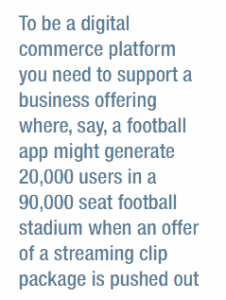Dave Labuda is the founder, chief executive and chief technology officer of MATRIXX Software, the provider of systems that enable digital commerce. Here, he tells George Malim that the functionality previously covered by the BSS domain is no longer about IT or the network. Instead, the responsibility for digital transformation is moving to chief digital officers who are specifying systems to enable new digital business models and brands.
VanillaPlus: Where did MATRIXX Software come from, and where are you going?
Dave Labuda: MATRIXX was born out of a culture and mission that started decades ago. I’ve been in the Silicon Valley for 30 years now and I’ve really enjoyed building software that solves real problems and provides real value. I’ve assembled a team that’s been working together for 20 years, having got into telecoms BSS with Portal Software before starting MATRIXX.
We’ve watched the mobile industry develop. When the iPhone came out we realised it wasn’t a phone, it was a window to the world and we recognised that would present a generational shift to the telecoms industry. Just like in the 1990s, with the emergence into the mainstream of the fixed internet, there was an opportunity for us to get involved in a generational change in consumer behaviour. Our opportunity was that mobile device makers focus on the marketing and sales elements of the device but tend to underestimate the problems behind the curtain.
We recognised that managing a network of 100 million smart devices was going to be much more difficult than previously thought so we worked to create a next generation platform and experience. In terms of where we’re going, our focus is on building more and more pieces of the platform to enable an end-to-end experience for communications service providers’ customers.

VP: What’s the single biggest challenge the telecoms industry faces?
DL: For me, there’s a great analogy to the US auto industry in the 1970s. The industry became fat and lazy because they made good money but they didn’t innovate to improve their customers’ experiences. Asian players came in and absolutely disrupted that industry. The same thing is happening in telecoms with the over-the-top (OTT) players. CSPs come from a regulated world where they had to ask the government to change the price of a service, so they didn’t see this transformation coming. The problem with that is you get behind very fast. That has now become apparent and some CSPs are losing 20% of their annual revenues as voice and data service incomes fall with nothing to replace them.
But the money is there if you add up the total communications-related services spend of users – it’s just that CSPs aren’t necessarily gathering their share. The CSPs stood at the kerb and watched this happen so they now have to fight for every dollar.
VP: MATRIXX talks about digital commerce instead of real-time charging or policy. Why is that?
DL: Because the real goal for us and for CSPs is the endto-end subscriber experience. What you see when you approach that is a dozen different boxes in the network including charging, policy and CRM. The reality is that you can’t create compelling customer experiences by duct taping together 12 systems, each with their own view – because you end up with a Frankenstein’s monster; consumers encounter a disconnected experience right at the very point where CSPs are trying to impress them.
We’re the only vendor in the market with a single coherent architecture across that entire end-to-end spectrum; we built real-time charging and policy together on the same platform. Vlocity and SalesForce are our partners, and they facilitate integrated CRM and make it available as a service from the cloud.
So many other vendors’ technologies are so cumbersome that their systems can’t deliver a compelling customer experience. Our strategy is to solve the end-toend problem without having those moving parts. One of the reasons why we win business from our customers – Swisscom, Telstra and PLDT are good examples – is that we take the pain out of integrating a new system. With MATRIXX, CSPs can launch a new digital brand in just three months, compared to three years for a big transformation project, and quite often, those projects fail. They’re always expensive, too.
 To be a digital commerce platform you need to support a business offering where, say, a football app might generate 20,000 users in a 90,000 seat football stadium when an offer of a streaming clip package is pushed out. Those 20,000 fans may all accept at once and expect to receive excellent service. If you try to support that offering with a classic system it is going to collapse in a heap.
To be a digital commerce platform you need to support a business offering where, say, a football app might generate 20,000 users in a 90,000 seat football stadium when an offer of a streaming clip package is pushed out. Those 20,000 fans may all accept at once and expect to receive excellent service. If you try to support that offering with a classic system it is going to collapse in a heap.
There is now a shift in how CSPs are looking at IT infrastructure and solving problems. 25% of mobile service providers have hired a chief digital officer in the last three years to drive digital transformation throughout the organisation. They’re change-makers, often hired from outside of the telecoms industry because they bring a new mindset. They’re not specifically focusing on policy or charging, or their network or IT systems, they’re thinking of how to deliver a digital experience to their customers.
All of our discussions are led by the chief marketing officer, the chief digital officer or the chief strategy officer. That’s a business-oriented view and that’s correct because this isn’t an IT project anymore.
VP: How does your partnership with Vlocity and Salesforce change anything in the race to go digital?
DL: The partnership essentially provides an MVNO in a box; an end-to-end solution that covers all business aspects and creates an absolutely real-time, precise and instantly gratifying view of the subscriber that can satisfy demand from any channel. It lets an organisation deploy an experience very quickly and capitalise on the new digital market, instead of facing a three-year billing project that misses the current window and is ultimately based on expensive, legacy technology.
It lets service providers get into the market and start delivering return on investment very quickly and has the advantage of letting them put their toe in the water and scale up if the offering is a success. There’s much lower risk and much faster time to return on investment.
VP: Doesn’t the Uberisation of telecoms mean that CSPs will inevitably make less money from their customers?
DL: We’ve had great business results from our customers so far. Telstra is a good example because they have been live on our platform for two years. They’ve increased their data ARPU by 5%, made significant cost savings in their contact centre operation, and they’ve achieved improved satisfaction, measured by Net Promoter Score. In addition, bill shock refunds have also decreased which means the increased spend is not surprising people. Customers are, as I said earlier, happy to spend money for good experiences.
VP: What questions do chief digital officers ask you behind closed doors?
DL: Essentially, what’s happened for the last 20 years is that IT and network departments have owned decision making and have tried to map solutions to the needs of the business. What’s happening now is the normal evaluation and procurement processes aren’t working so chief digital officers are asking for our help to get IT and network departments to see the magic and understand that the traditional approach will be dead before it produces fruit.
CDOs know the platform needs to be much more agile and that a lower cost set of solutions is needed for the business to drive into new markets. It’s a tricky game because there are a lot of careers depending on this.
VP: Some of your customers are also investors in MATRIXX. What’s the strategy behind that?
DL: There are tremendous advantages in both directions. From our point of view, having strategic customers become investors provides another pillar of strength in our relationship – these are marriages, not just dates. For instance, we’ve had relationships with Telstra and Swisscom through Portal for 25 years, and that adds another level of openness and commitment to the engagements.
The benefits for the investing CSP are that they get visibility into what’s going on at the company. The flipside is that the customers are putting a big bet on us so they want a reward for making that bet. That takes the shape of a financial return for them on our success.
This investment model helps alleviate the traditional concerns about what happens when a company like us gets bought by a one of the big vendors and the innovation stops. Financial investors have a horizon in mind by which they want to receive a return – but we’ve found investors who want a better alternative, a long-term relationship. The strategic investors will be as patient as we need because their goals are aligned to our goals. I think that puts us in a privileged position.






